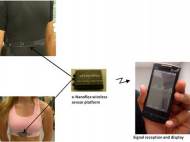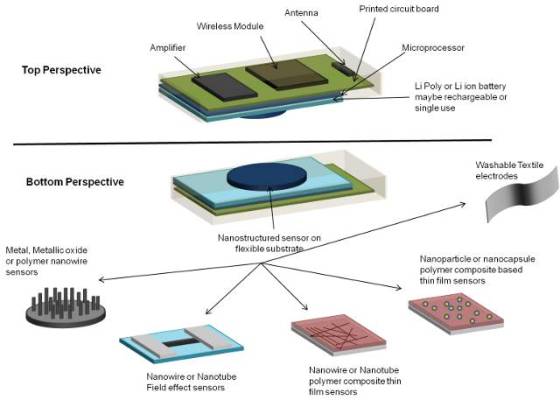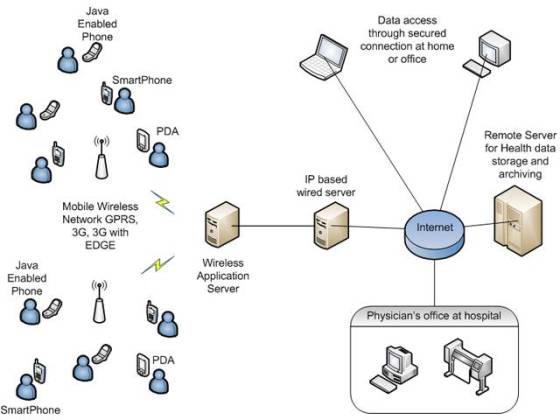e-Nanoflex Sensor System – physiological data textile sensor
 An interdisciplinary team of engineers at the University of Arkansas developed e-Nanoflex Sensor System – a wireless health-monitoring textile-based sensors that can be integrated into conventional sports bra or a vest. Since the monitored information can be sent in real time to a physician, hospital or the wearer’s smartphone, the technology enables easier monitoring of patients and a great way to monitor your physiological data while exercising.
An interdisciplinary team of engineers at the University of Arkansas developed e-Nanoflex Sensor System – a wireless health-monitoring textile-based sensors that can be integrated into conventional sports bra or a vest. Since the monitored information can be sent in real time to a physician, hospital or the wearer’s smartphone, the technology enables easier monitoring of patients and a great way to monitor your physiological data while exercising.
“Our e-bra enables continuous, real-time monitoring to identify any pathophysiological changes”, said Dr. Vijay Varadan, Distinguished Professor of electrical engineering. “It is a platform on which various sensors for cardiac-health monitoring are integrated into the fabric. The garment collects and transmits vital health signals to any desired location in the world.”
The e-Nanoflex Sensor System includes a series of nanostructured, textile sensors integrated into a conventional sports bra or a vest. The sensors, which are smaller than a dime, include gold nanowires, as well as flexible, conducting textile nanosensors which are woven into the supporting material. The nanowires are approximately 1 micrometer long and range from 20 nanometers to 200 nanometers in diameter.
Their small diameter enables creation of nanowire arrays which push a few nanometers into the skin, thus achieving two orders of magnitude increase of sensitivity to skin currents compared to planar electrodes. This makes it easier to separate heart signals from motion artifacts when walking, working, or exercising. These sensors also do not require conventional sticky electrodes or the use of gel used by other conventional sensors.
The sensors are manufactured by in a fairly low cost process called roll-to-roll electroplating. The process starts when a roll of wire or foil is unwound and coated with plastic. Lasers etch 20-to-200-nanometer-diameter holes into the coating, and current is run through the substrate as it is dipped into an electroplating bath. This attracts the metal ions, which form nanowires inside the holes created in the coating. The final step is the removal of the plastic coating via pyrolyzing – a process where plastic is burned off – which leaves only the metal nanowires behind.
Although small, the system is able to measure various physiological data such as blood pressure, body temperature, respiratory rate, oxygen consumption, some neural activity and all the readings provided by a conventional electrocardiograph (ECG), including the ability to display inverted T waves which indicate the onset of cardiac arrest.
Gathered data is sent to the snap-on wireless module which is housed in a plastic box that is slightly smaller than a ring box. The module is essentially a low-powered processing unit that includes an amplifier, an antenna, a printed circuit board, a microprocessor, a Bluetooth module, a battery and various sensors. University of Arkansas scientists expect that anticipated battery and Bluetooth upgrades will allow the researchers to build a smaller, lighter and flexible module that will be 38 mm (1.5 inches) long, 19 mm (0.75 inch) wide and 6.35 mm (0.25 inch) deep.
The sensors communicate with system software that relies on a smart phone to collect information, compress it and send it over a variety of wireless networks. The transferred data can be read by commercially available cell phones and hand-held devices, which expand the use of the system beyond health care.
By carrying a cell phone, athletes can monitor all signs mentioned above and other metrics, such as number of calories burned during a workout. To render clean data, the software includes filtering algorithms to mitigate problems due to motion of the hand-held device during exercise. Since it doesn’t require a cuff or any extra accessories to measure blood pressure, and it eliminates the need for wires needed for conventional ECG measuring, it is also far more comfortable for use in hospitals or in telemedicine applications.
Whether on a computer or cell phone, the software is set up so that users can view all data on one screen or window, or they can view each measurement on its own unique window. The software also includes a global positioning system that tracks the exact latitude and longitude of the patient or athlete. The geographic information is transferred to a cloud cluster and stored in a secured database that doctors or other health-care personnel can access to view location of the patient as well as historic or real-time ECG data. The system can also be programmed to send emergency messages, via voice or text messaging, if it detects extreme or abnormal conditions.
For more information, read the paper published in the Journal of Nanotechnology in Engineering and Medicine: “e-Nanoflex Sensor System: Smartphone-Based Roaming Health Monitor”.











Temos um projeto chamado http://www.boaspraticassaude.com.br no Brasil. Gostaríamos de saber qual a possibilidade de estarmos estreitando nossa parceria sobre a representação desta inovação.